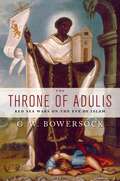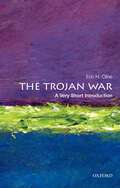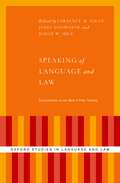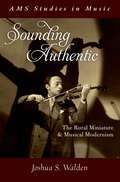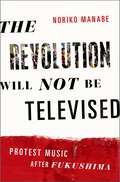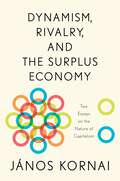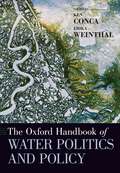- Table View
- List View
The Throne of Adulis: Red Sea Wars on the Eve of Islam (Emblems of Antiquity)
by G.W. BowersockJust prior to the rise of Islam in the sixth century AD, southern Arabia was embroiled in a violent conflict between Christian Ethiopians and Jewish Arabs. Though little known today, this was an international war that involved both the Byzantine Empire, which had established Christian churches in Ethiopia, and the Sasanian Empire in Persia, which supported the Jews in what became a proxy war against its longtime foe Byzantium. Our knowledge of these events derives largely from an inscribed marble throne at the Ethiopian port of Adulis, meticulously described by a sixth-century Christian merchant known as Cosmas Indicopleustes. Using the writings of Cosmas and a wealth of other historical and archaeological evidence from the period, eminent historian G. W. Bowersock carefully reconstructs this fascinating but overlooked chapter in pre-Islamic Arabian history. The flashpoint of the war, Bowersock tells us, occurred when Yusuf, the Jewish king of Himyar, massacred hundreds of Christians living in Najran. The Christian ruler of Ethiopia, Kaleb, urged on by the Byzantine emperor Justin, led a force of 120,000 men across the Red Sea to defeat Yusuf. But when the victorious Kaleb--said to have retired to a monastery-left behind weak leaders in both Ethiopia and Himyar, the Byzantine and Persian empires expanded their activity in the Arabian territory. In the midst of this conflict, a new religion was born, destined to bring a wholly unanticipated resolution to the power struggle in Arabia. The Throne of Adulis vividly recreates the Red Sea world of Late Antiquity, transporting readers back to a remote but pivotal epoch in ancient history, one that sheds light on the collapse of the Persian Empire as well as the rise of Islam.
The Oxford Handbook of the American Revolution (Oxford Handbooks)
The Oxford Handbook of the American Revolution draws on a wealth of new scholarship to create a vibrant dialogue among varied approaches to the revolution that made the United States. In thirty-three essays written by authorities on the period, the Handbook brings to life the diverse multitudes of colonial North America and their extraordinary struggles before, during, and after the eight-year-long civil war that secured the independence of thirteen rebel colonies from their erstwhile colonial parent. The chapters explore battles and diplomacy, economics and finance, law and culture, politics and society, gender, race, and religion. Its diverse cast of characters includes ordinary farmers and artisans, free and enslaved African Americans, Indians, and British and American statesmen and military leaders. In addition to expanding the Revolution's who, the Handbook broadens its where, portraying an event that far transcended the boundaries of what was to become the United States. It offers readers an American Revolution whose impact ranged far beyond the thirteen colonies. The Handbook's range of interpretive and methodological approaches captures the full scope of current revolutionary-era scholarship. Its authors, British and American scholars spanning several generations, include social, cultural, military, and imperial historians, as well as those who study politics, diplomacy, literature, gender, and sexuality. Together and separately, these essays demonstrate that the American Revolution remains a vibrant and inviting a subject of inquiry. Nothing comparable has been published in decades.
The Oxford Handbook of Warfare in the Classical World (Oxford Handbooks)
by Brian Campbell, Lawrence A. TritleThis Handbook gathers 38 leading historians to describe, analyze, and interpret warfare and its effects in classical Greece and Rome.
The Trojan War: A Very Short Introduction (Very Short Introductions)
by Eric H. ClineThe Iliad, Homer's epic tale of the abduction of Helen and the decade-long Trojan War, has fascinated mankind for millennia. Even today, the war inspires countless articles and books, extensive archaeological excavations, movies, television documentaries, even souvenirs and collectibles. But while the ancients themselves believed that the Trojan War took place, scholars of the modern era have sometimes derided it as a piece of fiction. Combining archaeological data and textual analysis of ancient documents, this Very Short Introduction considers whether or not the war actually took place and whether archaeologists have really discovered the site of ancient Troy. To answer these questions, archaeologist and ancient historian Eric H. Cline examines various written sources, including the works of Homer, the Epic Cycle (fragments from other, now-lost Greek epics), classical plays, and Virgil's Aeneid. Throughout, the author tests the literary claims against the best modern archaeological evidence, showing for instance that Homer, who lived in the Iron Age, for the most part depicted Bronze Age warfare with accuracy. Cline also tells the engaging story of the archaeologists--Heinrich Schliemann and his successors Wilhelm Dörpfeld, Carl Blegen, and Manfred Korfmann--who found the long-vanished site of Troy through excavations at Hisarlik, Turkey. Drawing on evidence found at Hisarlik and elsewhere, Cline concludes that a war or wars in the vicinity of Troy probably did take place during the Late Bronze Age, forming the nucleus of a story that was handed down orally for centuries until put into final form by Homer. But Cline suggests that, even allowing that a Trojan War took place, it probably was not fought because of Helen's abduction, though such an incident may have provided the justification for a war actually fought for more compelling economic and political motives. About the Series: Oxford's Very Short Introductions series offers concise and original introductions to a wide range of subjects--from Islam to Sociology, Politics to Classics, Literary Theory to History, and Archaeology to the Bible. Not simply a textbook of definitions, each volume in this series provides trenchant and provocative--yet always balanced and complete--discussions of the central issues in a given discipline or field. Every Very Short Introduction gives a readable evolution of the subject in question, demonstrating how the subject has developed and how it has influenced society. Eventually, the series will encompass every major academic discipline, offering all students an accessible and abundant reference library. Whatever the area of study that one deems important or appealing, whatever the topic that fascinates the general reader, the Very Short Introductions series has a handy and affordable guide that will likely prove indispensable.
The Throne of Adulis: Red Sea Wars on the Eve of Islam (Emblems of Antiquity)
by G.W. BowersockJust prior to the rise of Islam in the sixth century AD, southern Arabia was embroiled in a violent conflict between Christian Ethiopians and Jewish Arabs. Though little known today, this was an international war that involved both the Byzantine Empire, which had established Christian churches in Ethiopia, and the Sasanian Empire in Persia, which supported the Jews in what became a proxy war against its longtime foe Byzantium. Our knowledge of these events derives largely from an inscribed marble throne at the Ethiopian port of Adulis, meticulously described by a sixth-century Christian merchant known as Cosmas Indicopleustes. Using the writings of Cosmas and a wealth of other historical and archaeological evidence from the period, eminent historian G. W. Bowersock carefully reconstructs this fascinating but overlooked chapter in pre-Islamic Arabian history. The flashpoint of the war, Bowersock tells us, occurred when Yusuf, the Jewish king of Himyar, massacred hundreds of Christians living in Najran. The Christian ruler of Ethiopia, Kaleb, urged on by the Byzantine emperor Justin, led a force of 120,000 men across the Red Sea to defeat Yusuf. But when the victorious Kaleb--said to have retired to a monastery-left behind weak leaders in both Ethiopia and Himyar, the Byzantine and Persian empires expanded their activity in the Arabian territory. In the midst of this conflict, a new religion was born, destined to bring a wholly unanticipated resolution to the power struggle in Arabia. The Throne of Adulis vividly recreates the Red Sea world of Late Antiquity, transporting readers back to a remote but pivotal epoch in ancient history, one that sheds light on the collapse of the Persian Empire as well as the rise of Islam.
Popularizing Science: The Life and Work of JBS Haldane
by Krishna DronamrajuJ.B.S. Haldane (1892-1964) is widely appreciated as one of the greatest and most influential British scientists of the 20th century, making significant contributions to genetics, physiology, biochemistry, biometry, cosmology, and other sciences. More remarkable, then, is the fact that Haldane had no formal qualification in science. He made frequent appearances in the media, making pronouncements on a variety of poignant topics including mining disasters, meteorites, politics, and the economy, and was a popular scientific essay writer. Haldane also was famed for conducting painful experiments on himself, including several instances in which he permanently injured himself. A staunch Marxist and convert to Hinduism, Haldane lived a diverse, lively and interesting life that is still revered by today's science community. A biography of Haldane has not been attempted since 1968, and that book provided an incomplete account of the man's scientific achievement. "The Life and Works of J.B.S. Haldane" serves to fix this glaring omission, providing a complete biographical sketch written by Krishna Dronamraju, one of the last living men to have worked personally with Haldane. A new genre of biographies of 20th-century scientists has come into being, and thus far works have been written about men like Einstein, Oppenheimer, Bernal, Galton, and many more; the inclusion of Haldane within this genre is an absolute necessity. Dronamraju evaluates Haldane's social and political background, as well as his scientific creativity and accomplishments. Haldane embodies a generation of intellectuals who believed and promoted knowledge for its own sake, and that spirit of scientific curiosity and passion is captured in this biography.
LIFE & WORK OF JBS HALDANE C: The Life and Work of JBS Haldane
by Krishna DronamrajuJ.B.S. Haldane (1892-1964) is widely appreciated as one of the greatest and most influential British scientists of the 20th century, making significant contributions to genetics, physiology, biochemistry, biometry, cosmology, and other sciences. More remarkable, then, is the fact that Haldane had no formal qualification in science. He made frequent appearances in the media, making pronouncements on a variety of poignant topics including mining disasters, meteorites, politics, and the economy, and was a popular scientific essay writer. Haldane also was famed for conducting painful experiments on himself, including several instances in which he permanently injured himself. A staunch Marxist and convert to Hinduism, Haldane lived a diverse, lively and interesting life that is still revered by today's science community. A biography of Haldane has not been attempted since 1968, and that book provided an incomplete account of the man's scientific achievement. "The Life and Works of J.B.S. Haldane" serves to fix this glaring omission, providing a complete biographical sketch written by Krishna Dronamraju, one of the last living men to have worked personally with Haldane. A new genre of biographies of 20th-century scientists has come into being, and thus far works have been written about men like Einstein, Oppenheimer, Bernal, Galton, and many more; the inclusion of Haldane within this genre is an absolute necessity. Dronamraju evaluates Haldane's social and political background, as well as his scientific creativity and accomplishments. Haldane embodies a generation of intellectuals who believed and promoted knowledge for its own sake, and that spirit of scientific curiosity and passion is captured in this biography.
Apostles of Reason: The Crisis of Authority in American Evangelicalism
by Molly WorthenEvangelical Christianity is a paradox. Evangelicals are radically individualist, but devoted to community and family. They believe in the transformative power of a personal relationship with God, but are wary of religious enthusiasm. They are deeply skeptical of secular reason, but eager to find scientific proof that the Bible is true. In this groundbreaking history of modern American evangelicalism, Molly Worthen argues that these contradictions are the products of a crisis of authority that lies at the heart of the faith. Evangelicals have never had a single authority to guide them through these dilemmas or settle the troublesome question of what the Bible actually means. Worthen chronicles the ideological warfare, institutional conflict, and clashes between modern gurus and maverick disciples that lurk behind the more familiar narrative of the rise of the Christian Right. The result is an ambitious intellectual history that weaves together stories from all corners of the evangelical world to explain the ideas and personalities-the scholarly ambitions and anti-intellectual impulses-that have made evangelicalism a cultural and political force. In Apostles of Reason, Worthen recasts American evangelicalism as a movement defined not by shared doctrines or politics, but by the problem of reconciling head knowledge and heart religion in an increasingly secular America. She shows that understanding the rise of the Christian Right in purely political terms, as most scholars have done, misses the heart of the story. The culture wars of the late twentieth century emerged not only from the struggle between religious conservatives and secular liberals, but also from the civil war within evangelicalism itself-a battle over how to uphold the commands of both faith and reason, and how ultimately to lead the nation back onto the path of righteousness.
Speaking of Language and Law: Conversations on the Work of Peter Tiersma (Oxford Studies in Language and Law)
Among the most prominent scholars of language and law is Peter Tiersma, a law professor at Loyola Law School with a doctorate in linguistics (co-editor of The Oxford Handbook of Language and Law). Tiersma's significant body of work traverses a variety of legal and linguistic fields. This book offers a selection of twelve of Tiersma's most influential publications, divided into five thematic areas that are critical to both law and linguistics: Language and Law as a Field of Inquiry, Legal Language and its History, Language and Civil Liability, Language and Criminal Justice, and Jury Instructions. Each paper is accompanied by a brief commentary from a leading scholar in the field, offering a substantive conversation about the ramifications of Tiersma's work and the disagreements that have often surrounded it.
Denial of Violence: Ottoman Past, Turkish Present, and Collective Violence against the Armenians, 1789-2009
by Fatma Muge GocekWhile much of the international community regards the forced deportation of Armenian subjects of the Ottoman Empire in 1915, where approximately 800,000 to 1.5 million Armenians perished, as genocide, the Turkish state still officially denies it. In Denial of Violence, Fatma Müge Göçek seeks to decipher the roots of this disavowal. To capture the negotiation of meaning that leads to denial, Göçek undertook a qualitative analysis of 315 memoirs published in Turkey from 1789 to 2009 in addition to numerous secondary sources, journals, and newspapers. She argues that denial is a multi-layered, historical process with four distinct yet overlapping components: the structural elements of collective violence and situated modernity on one side, and the emotional elements of collective emotions and legitimating events on the other. In the Turkish case, denial emerged through four stages: (i) the initial imperial denial of the origins of the collective violence committed against the Armenians commenced in 1789 and continued until 1907; (ii) the Young Turk denial of the act of violence lasted for a decade from 1908 to 1918; (iii) early republican denial of the actors of violence took place from 1919 to 1973; and (iv) the late republican denial of the responsibility for the collective violence started in 1974 and continues today. Denial of Violence develops a novel theoretical, historical and methodological framework to understanding what happened and why the denial of collective violence against Armenians still persists within Turkish state and society.
Exodus and Liberation: Deliverance Politics from John Calvin to Martin Luther King Jr.
by John CoffeyBiblical texts have been one of the most potent sources in the Western political imagination. Presenting a new account of how the Bible's liberationist texts were deployed and disputed at critical junctures in British and American history from the Reformation to the Civil Rights Movement, Exodus and Liberation argues that the Exodus story carried one of the big ideas in Anglophone political culture - the idea of deliverance. In the sixteenth century, Calvinist rebels and reformers identified with Old Testament Israel as they sought liberation from "popish bondage." The Puritan Revolution of 1640-60 was depicted as England's Exodus, provoking a fierce contest for control of the biblical story. In the Glorious Revolution and the American Revolution, Protestants turned the Exodus narrative and deliverance language against "political slavery." Revolutionary rhetoric exposed the contradiction between libertarian ideology and black chattel slavery. Abolitionists forged a theology of liberation, articulated in resonant biblical mottoes: "Let my People Go!", "Proclaim Liberty throughout the Land," "Break every Yoke", "Release the Oppressed." African Americans cast themselves as the Children of Israel, forging a distinct identity and throwing into question the scriptural construction of the United States. Black migrations to the North were imagined as journeys to the Promised Land, and black Exodus politics climaxed in the speeches of Martin Luther King Jr. Among American statesmen, foreign policy rhetoric continued to yoke Providence to Liberation. By the twenty-first century, both George W. Bush and Barack Obama laid claim to the Exodus story. Using sermons, speeches, pamphlets, song, verse, and iconography, Exodus and Liberation documents the extraordinary reach of these biblical traditions, demonstrating how the political reading of scriptural texts powerfully informed Protestant debates over slavery and liberty.
Exodus and Liberation: Deliverance Politics from John Calvin to Martin Luther King Jr.
by John CoffeyBiblical texts have been one of the most potent sources in the Western political imagination. Presenting a new account of how the Bible's liberationist texts were deployed and disputed at critical junctures in British and American history from the Reformation to the Civil Rights Movement, Exodus and Liberation argues that the Exodus story carried one of the big ideas in Anglophone political culture - the idea of deliverance. In the sixteenth century, Calvinist rebels and reformers identified with Old Testament Israel as they sought liberation from "popish bondage." The Puritan Revolution of 1640-60 was depicted as England's Exodus, provoking a fierce contest for control of the biblical story. In the Glorious Revolution and the American Revolution, Protestants turned the Exodus narrative and deliverance language against "political slavery." Revolutionary rhetoric exposed the contradiction between libertarian ideology and black chattel slavery. Abolitionists forged a theology of liberation, articulated in resonant biblical mottoes: "Let my People Go!", "Proclaim Liberty throughout the Land," "Break every Yoke", "Release the Oppressed." African Americans cast themselves as the Children of Israel, forging a distinct identity and throwing into question the scriptural construction of the United States. Black migrations to the North were imagined as journeys to the Promised Land, and black Exodus politics climaxed in the speeches of Martin Luther King Jr. Among American statesmen, foreign policy rhetoric continued to yoke Providence to Liberation. By the twenty-first century, both George W. Bush and Barack Obama laid claim to the Exodus story. Using sermons, speeches, pamphlets, song, verse, and iconography, Exodus and Liberation documents the extraordinary reach of these biblical traditions, demonstrating how the political reading of scriptural texts powerfully informed Protestant debates over slavery and liberty.
Jonas Salk: A Life
by Charlotte DeCroes JacobsWhen a waiting world learned on April 12, 1955, that Jonas Salk had successfully created a vaccine to prevent poliomyelitis, he became a hero overnight. Born in a New York tenement, humble in manner, Salk had all the makings of a twentieth-century icon--a knight in a white coat. In the wake of his achievement, he received a staggering number of awards and honors; for years his name ranked with Gandhi and Churchill on lists of the most revered people. And yet the one group whose adulation he craved--the scientific community--remained ominously silent. "The worst tragedy that could have befallen me was my success," Salk later said. "I knew right away that I was through--cast out." In the first complete biography of Jonas Salk, Charlotte DeCroes Jacobs unravels Salk's story to reveal an unconventional scientist and a misunderstood and vulnerable man. Despite his incredible success in developing the polio vaccine, Salk was ostracized by his fellow scientists, who accused him of failing to give proper credit to other researchers and scorned his taste for media attention. Even before success catapulted him into the limelight, Salk was an inscrutable man disliked by many of his peers. Driven by an intense desire to aid mankind, he was initially oblivious and eventually resigned to the personal cost--as well as the costs suffered by his family and friends. And yet Salk remained, in the eyes of the public, an adored hero. Based on hundreds of personal interviews and unprecedented access to Salk's sealed archives, Jacobs' biography offers the most complete picture of this complicated figure. Salk's story has never been fully told; until now, his role in preventing polio has overshadowed his part in co-developing the first influenza vaccine, his effort to meld the sciences and humanities in the magnificent Salk Institute, and his pioneering work on AIDS. A vivid and intimate portrait, this will become the standard work on the remarkable life of Jonas Salk.
Jonas Salk: A Life
by Charlotte DeCroes JacobsWhen a waiting world learned on April 12, 1955, that Jonas Salk had successfully created a vaccine to prevent poliomyelitis, he became a hero overnight. Born in a New York tenement, humble in manner, Salk had all the makings of a twentieth-century icon--a knight in a white coat. In the wake of his achievement, he received a staggering number of awards and honors; for years his name ranked with Gandhi and Churchill on lists of the most revered people. And yet the one group whose adulation he craved--the scientific community--remained ominously silent. "The worst tragedy that could have befallen me was my success," Salk later said. "I knew right away that I was through--cast out." In the first complete biography of Jonas Salk, Charlotte DeCroes Jacobs unravels Salk's story to reveal an unconventional scientist and a misunderstood and vulnerable man. Despite his incredible success in developing the polio vaccine, Salk was ostracized by his fellow scientists, who accused him of failing to give proper credit to other researchers and scorned his taste for media attention. Even before success catapulted him into the limelight, Salk was an inscrutable man disliked by many of his peers. Driven by an intense desire to aid mankind, he was initially oblivious and eventually resigned to the personal cost--as well as the costs suffered by his family and friends. And yet Salk remained, in the eyes of the public, an adored hero. Based on hundreds of personal interviews and unprecedented access to Salk's sealed archives, Jacobs' biography offers the most complete picture of this complicated figure. Salk's story has never been fully told; until now, his role in preventing polio has overshadowed his part in co-developing the first influenza vaccine, his effort to meld the sciences and humanities in the magnificent Salk Institute, and his pioneering work on AIDS. A vivid and intimate portrait, this will become the standard work on the remarkable life of Jonas Salk.
Sounding Authentic: The Rural Miniature and Musical Modernism (AMS Studies in Music)
by Joshua S. WaldenSounding Authentic considers the intersecting influences of nationalism, modernism, and technological innovation on representations of ethnic and national identities in twentieth-century art music. Author Joshua S. Walden discusses these forces through the prism of what he terms the "rural miniature": short violin and piano pieces based on folk song and dance styles. This genre, mostly inspired by the folk music of Hungary, the Jewish diaspora, and Spain, was featured frequently on recordings and performance programs in the early twentieth century. Furthermore, Sounding Authentic shows how the music of urban Romany ensembles developed into nineteenth-century repertoire of virtuosic works in the style hongrois before ultimately influencing composers of rural miniatures. Walden persuasively demonstrates how rural miniatures represented folk and rural cultures in a manner that was perceived as authentic, even while they involved significant modification of the original sources. He also links them to the impulse toward realism in developing technologies of photography, film, and sound recording. Sounding Authentic examines the complex ways the rural miniature was used by makers of nationalist agendas, who sought folkloric authenticity as a basis for the construction of ethnic and national identities. The book also considers the genre's reception in European diaspora communities in America where it evoked and transformed memories of life before immigration, and traces how many rural miniatures were assimilated to the styles of American popular song and swing. Scholars interested in musicology, ethnography, the history of violin performance, twentieth-century European art music, the culture of the Jewish Diaspora and more will find Sounding Authentic an essential addition to their library.
The Revolution Will Not Be Televised: Protest Music After Fukushima
by Noriko ManabeNuclear power has been a contentious issue in Japan since the 1950s, and in the aftermath of the Fukushima nuclear power plant disaster, the conflict has only grown. Government agencies and the nuclear industry continue to push a nuclear agenda, while the mainstream media adheres to the official line that nuclear power is Japan's future. Public debate about nuclear energy is strongly discouraged. Nevertheless, antinuclear activism has swelled into one of the most popular and passionate movements in Japan, leading to a powerful wave of protest music. The Revolution Will Not Be Televised: Protest Music After Fukushima shows that music played a central role in expressing antinuclear sentiments and mobilizing political resistance in Japan. Combining musical analysis with ethnographic participation, author Noriko Manabe offers an innovative typology of the spaces central to the performance of protest music--cyberspace, demonstrations, festivals, and recordings. She argues that these four spaces encourage different modes of participation and methods of political messaging. The openness, mobile accessibility, and potential anonymity of cyberspace have allowed musicians to directly challenge the ethos of silence that permeated Japanese culture post-Fukushima. Moving from cyberspace to real space, Manabe shows how the performance and reception of music played at public demonstrations are shaped by the urban geographies of Japanese cities. While short on open public space, urban centers in Japan offer protesters a wide range of governmental and commercial spaces in which to demonstrate, with activist musicians tailoring their performances to the particular landscapes and soundscapes of each. Music festivals are a space apart from everyday life, encouraging musicians and audience members to freely engage in political expression through informative and immersive performances. Conversely, Japanese record companies and producers discourage major-label musicians from expressing political views in recordings, forcing antinuclear musicians to express dissent indirectly: through allegories, metaphors, and metonyms. The first book on Japan's antinuclear music, The Revolution Will Not Be Televised provides a compelling new perspective on the role of music in political movements.
Dynamism, Rivalry, and the Surplus Economy: Two Essays on the Nature of Capitalism
by János KornaiIn Dynamism, Rivalry, and the Surplus Economy, János Kornai examines capitalism as an economic system and in comparison to socialism. Kornai explains his view of capitalism as an economy of surplus--a chronic excess of supply of goods and labor. This environment breeds rivalry among producers, which in turn encourages innovation. Socialism, on the other hand, is defined by a shortage of goods and labor and excess of demand. Whereas socialism is slothful and imitative, capitalism is dynamic and progressive. The two essays of this book will explore these differing ideologies on macro and micro levels, ending with definitive explanations of how the systems work and how they develop.
Dynamism, Rivalry, and the Surplus Economy: Two Essays on the Nature of Capitalism
by János KornaiIn Dynamism, Rivalry, and the Surplus Economy, János Kornai examines capitalism as an economic system and in comparison to socialism. Kornai explains his view of capitalism as an economy of surplus--a chronic excess of supply of goods and labor. This environment breeds rivalry among producers, which in turn encourages innovation. Socialism, on the other hand, is defined by a shortage of goods and labor and excess of demand. Whereas socialism is slothful and imitative, capitalism is dynamic and progressive. The two essays of this book will explore these differing ideologies on macro and micro levels, ending with definitive explanations of how the systems work and how they develop.
Heirs of the Fisherman: Behind the Scenes of Papal Death and Succession
by John-Peter PhamThe death of Pope John Paul II and consequent election of Pope Benedict XVI has shed light on a political process that the world has not been privy to for almost twenty-six years. People from around the world gathered in St. Peter's Square, wondering who the next Vatican leader would be and how the election process really worked, while everyone from international news correspondents to local priests added their own opinions to the debate. In Heirs of the Fisherman, former Vatican insider John-Peter Pham presents a candid portrait of the modern Vatican, the only account to reveal the striking changes to papal succession procedures made by John Paul II. Blending political and ecclesiastical history, Pham goes beyond a mere description of the complex rituals to offer rare insight into the dramatic shifts inside the College of Cardinals, whose 100 members now hail from 50 nations around the globe. He takes us into the secret conclave, where the electors were kept under lock and key, until they had selected a new pope. He also includes a chapter devoted to the intrigues of the 20th century where the first conclave had an emperor's veto and the last was won by the first non-Italian in four centuries becauase the Italians were bitterly divided. With a new Preface, Afterword, and appendices that include an English translation of the last will and testament of Pope John Paul II, Heirs of the Fisherman is an illuminating history and must-have guide to this vitally important world event. It will continue to be an indispensable reference to observers of future Catholic Church politics.
The Synthesizer: A Comprehensive Guide to Understanding, Programming, Playing, and Recording the Ultimate Electronic Music Instrument
by Mark VailElectronic music instruments weren't called synthesizers until the 1950s, but their lineage began in 1919 with Russian inventor Lev Sergeyevich Termen's development of the Etherphone, now known as the Theremin. From that point, synthesizers have undergone a remarkable evolution from prohibitively large mid-century models confined to university laboratories to the development of musical synthesis software that runs on tablet computers and portable media devices. Throughout its history, the synthesizer has always been at the forefront of technology for the arts. In The Synthesizer: A Comprehensive Guide to Understanding, Programming, Playing, and Recording the Ultimate Electronic Music Instrument, veteran music technology journalist, educator, and performer Mark Vail tells the complete story of the synthesizer: the origins of the many forms the instrument takes; crucial advancements in sound generation, musical control, and composition made with instruments that may have become best sellers or gone entirely unnoticed; and the basics and intricacies of acoustics and synthesized sound. Vail also describes how to successfully select, program, and play a synthesizer; what alternative controllers exist for creating electronic music; and how to stay focused and productive when faced with a room full of instruments. This one-stop reference guide on all things synthesizer also offers tips on encouraging creativity, layering sounds, performance, composing and recording for film and television, and much more.
The Synthesizer: A Comprehensive Guide to Understanding, Programming, Playing, and Recording the Ultimate Electronic Music Instrument
by Mark VailElectronic music instruments weren't called synthesizers until the 1950s, but their lineage began in 1919 with Russian inventor Lev Sergeyevich Termen's development of the Etherphone, now known as the Theremin. From that point, synthesizers have undergone a remarkable evolution from prohibitively large mid-century models confined to university laboratories to the development of musical synthesis software that runs on tablet computers and portable media devices. Throughout its history, the synthesizer has always been at the forefront of technology for the arts. In The Synthesizer: A Comprehensive Guide to Understanding, Programming, Playing, and Recording the Ultimate Electronic Music Instrument, veteran music technology journalist, educator, and performer Mark Vail tells the complete story of the synthesizer: the origins of the many forms the instrument takes; crucial advancements in sound generation, musical control, and composition made with instruments that may have become best sellers or gone entirely unnoticed; and the basics and intricacies of acoustics and synthesized sound. Vail also describes how to successfully select, program, and play a synthesizer; what alternative controllers exist for creating electronic music; and how to stay focused and productive when faced with a room full of instruments. This one-stop reference guide on all things synthesizer also offers tips on encouraging creativity, layering sounds, performance, composing and recording for film and television, and much more.
Burmese Lives: Ordinary Life Stories Under the Burmese Regime
This volume explores the life stories of ordinary Burmese by drawing on the narratives of individual subjects and using an array of interdisciplinary approaches, covering anthropology, history, literature, ethnomusicology, economics and political science. Burma is one of the most diverse societies in Southeast Asia in terms of its ethnic composition. It has a long history of resistance from the public realm against colonial rule and post-independence regimes. However, its isolation for decades before 1988 deprived scholars of a close look into the many faces of this society. Looking into the life stories of members of several major ethnic communities, who hail from different occupations and are of different ages and genders, this book has a particular significance that would help reveal the multiplicities of Burma's modern history. The authors of this volume write about stories of their long-term informants, close friends, family members, or even themselves to bring out a wide range of issues relating to migration, economy, politics, religion and culture. The constituted stories jointly highlight the protagonists' survival strategies in everyday life that demonstrate their constant courage, pain and frustration in dealing with numerous social injustices and adversities. Through these stories, we see movement of lives as well as that of Burmese society.
The Oxford Handbook of Water Politics and Policy (Oxford Handbooks)
Water is a basic human need and a scarce commodity with increasing value to farmers, industries, and cities in an urbanizing world. It is unpredictable in supply and quality, difficult to contain or direct, and notoriously difficult to manage well. Several trends -- climate change, the endurance of widespread global water poverty, intensifying competition among rival uses and users, and the vulnerability of critical freshwater ecosystems -- combine to intensify the challenges of governing water wisely, fairly, and efficiently. The twenty-seven chapters in The Oxford Handbook of Water Politics and Policy address such issues over the course of seven thematic sections. These themes reflect familiar frameworks in the water policy world, including water, poverty, and health; water and nature; and water equity and justice. Other sections look at emergent and contentious policy arenas, including the water/energy/food nexus and management of uncertainty in water supply, or connect well-established strands in new ways, including sections on water tools (water price and value, supply and demand, privatization, corporate responsibility) and issues surrounding transboundary waters. This volume conceives of water as a global issue, and gathers a diverse group of leading scholars of water politics and policy.
The Other Gospels: Accounts of Jesus from Outside the New Testament
by Bart D. Ehrman Zlatko PleseBart Ehrman--the New York Times bestselling author of Misquoting Jesus and a recognized authority on the early Christian Church--and Zlatko Plese--a foremost authority on Christian Gnosticism--here offer a valuable compilation of over 40 ancient gospel texts and textual fragments that do not appear in the New Testament. This comprehensive collection contains Gospels describing Jesus's infancy, ministry, Passion, and resurrection, and includes the controversial manuscript discoveries of modern times, such as the Gospel of Thomas and the most recent Gospel to be discovered, the Gospel of Judas Iscariot. Each translation begins with a thoughtful examination of important historical, literary, and textual issues in order to place the Gospel in its proper context. This volume is an invaluable resource for anyone interested in early Christianity and the deeper meanings of these apocryphal Gospels.
The Other Gospels: Accounts of Jesus from Outside the New Testament
by Bart D. Ehrman Zlatko PleseBart Ehrman--the New York Times bestselling author of Misquoting Jesus and a recognized authority on the early Christian Church--and Zlatko Plese--a foremost authority on Christian Gnosticism--here offer a valuable compilation of over 40 ancient gospel texts and textual fragments that do not appear in the New Testament. This comprehensive collection contains Gospels describing Jesus's infancy, ministry, Passion, and resurrection, and includes the controversial manuscript discoveries of modern times, such as the Gospel of Thomas and the most recent Gospel to be discovered, the Gospel of Judas Iscariot. Each translation begins with a thoughtful examination of important historical, literary, and textual issues in order to place the Gospel in its proper context. This volume is an invaluable resource for anyone interested in early Christianity and the deeper meanings of these apocryphal Gospels.
